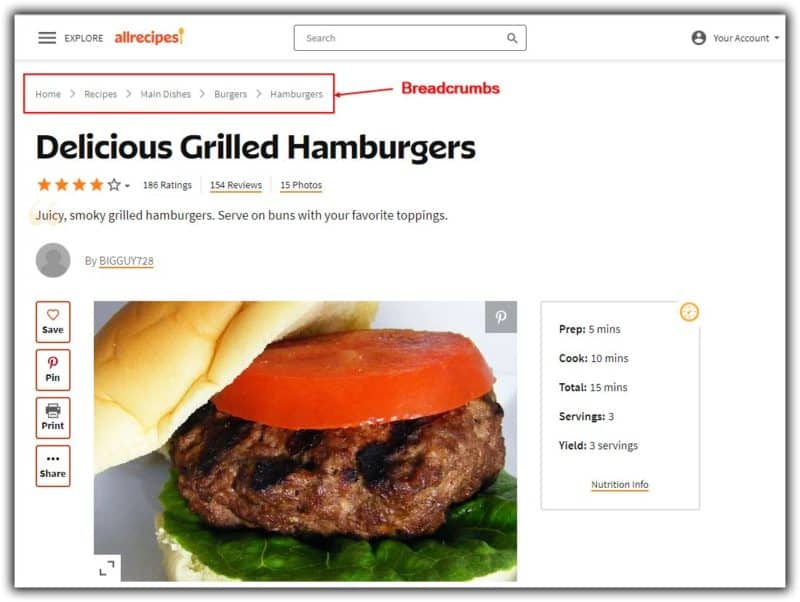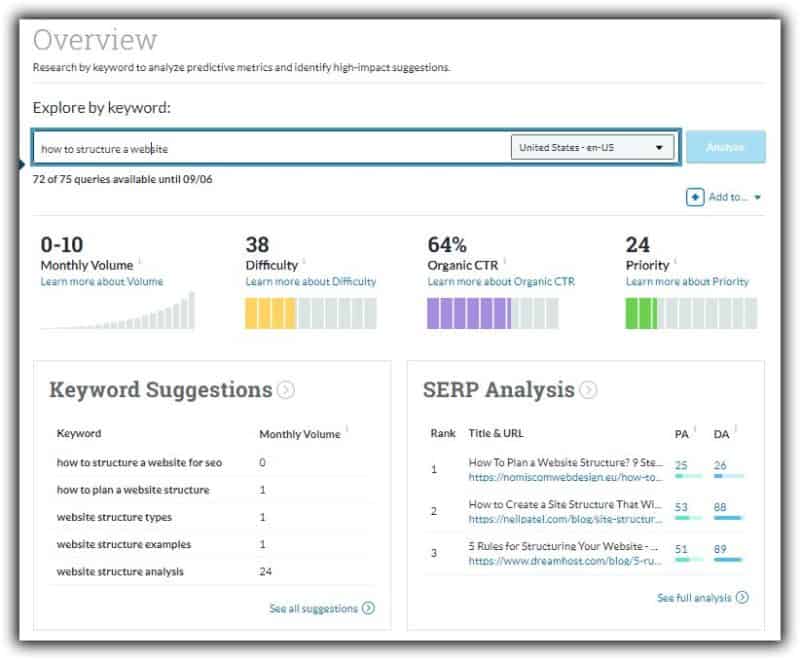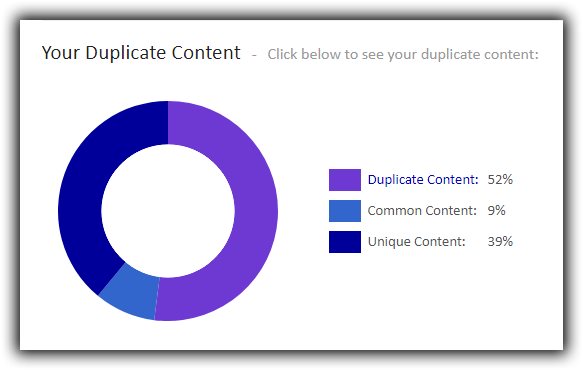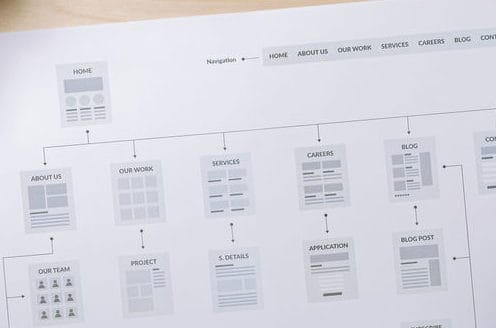Estimated Read Time: 14 Minutes
Years ago I was called for a job interview at a well-known bank. The meeting was to be held on the top floor of one of the tallest buildings in Wilmington Delaware. My stress level immediately went up. Without asking, I knew there was a good chance I’d be speaking with a corporate executive. How did I know? Because executives typically have their offices on the top floor of a building where the rent is highest, the views are best, and they’re bound to make an impression.
Your website structure, like a building layout, can be a silent and powerful communication tool. When your site is thoughtfully and purposefully structured, it helps you rank in search results and your audience find what they came looking for. A good website structure:
- quickly and quietly communicates your site’s most valued and important content to search engines, prospects, and customers;
- orients visitors quickly and eases site navigation; and
- provides a robust and meaningful framework for assessing your site’s health and performance.
These are the underpinnings of website success.
This post describes how to structure a small business website for SEO. It describes what is meant by website structure, why it is important, best practices, and highlights some of the most common shortcomings observed in practice.
The intent of this post is to help position you for search engine optimization (SEO) success.
What is Site Structure?
Site structure refers to the way that a site’s content – its applications, text, images, videos, music, folders, and more – is grouped, interconnected, and presented to human and non-human visitors. It establishes the order in which content is discovered, accessed, interpreted, and used.

Think of it like you would a restaurant menu. You want people to get oriented quickly and to enjoy the experience of navigating the menu and deciding what they want to order. You don’t want to overwhelm them with too many options at once. Instead, it is better to ease them in gently with selections laid out hierarchically, in a limited number of logical categories and subcategories. Appetizers go first, then main courses, salads, and desserts. No surprises. It is easy for visitors to quickly find what they came looking for and get on with their life.
How is Site Structure Implemented?
Site structure is implemented using directories, folders, and links.
- Website folders and directories group content into meaningful collections. Groupings determine how different pieces relate to one another and which ones are most important. On a website, content is grouped into directories and folders by assigning a parent (for pages) or permalink structure (for blog posts), and categories and/or tags (for blog posts).
- Website links connect related content, both on and offsite. They ease and speed navigation. On a website, links are the unique web address or URL (uniform resource locator) for a specific piece of content, folder, or directory. The link allows human and non-human visitors to navigate to the content directly. When links have meaningful names, they help humans and search engines get oriented and set context and expectations about destination content.
- Website menus and breadcrumbs are another way of providing context, another way of helping visitors get oriented quickly, keep track of where they are, reduce the number of clicks needed to get to where they want to go, and generally ease and speed navigation.
Some website development tools afford limited control over your site structure. It is best to consult with an SEO specialist before you make your purchase decision and begin design and development.
Why Is Site Structure Important?

Site Structure Puts You In Control – Photo by Hannes Egler on Unsplash
Site structure is important because it gives you a way to:
- signal your priorities and relevance to search engines,
- ease visitor orientation and navigation, and
- assess your website’s overall health and performance.
Website structure puts you in control.
Signal Your Priorities
Search engines only rank content they know about. When a potential visitor types a query into Google, Google doesn’t search the entire Internet when looking for matches. It instead searches its online index of all the Internet content it was previously able to discover. If your new or updated content is not in Google’s index, it won’t be ranked and it won’t show up in search results.
Google’s index is similar to a library’s index. The index contains information about all the books in the library or, in Google’s case, all the web content it knows about. When Google visits your website, it detects new, changed, and deleted content as it updates its index.

Google discovers content by following links from one page to another. If your content has no incoming links, it won’t get indexed and it won’t show up in search results. If your content is buried deep in your site and is rarely visited by a search engine, it will show up in search results but it could be outdated. Structuring your content top-down with the most important items presented first helps search engines discover and update your most important content first and fastest.
Links pass link equity. Link equity is a search engine ranking factor based on the premise that links signal trust; that the source of the link is recommending your content to their readers. The more authoritative and trustworthy the source of the link, the greater the positive impact it will have on your rankings.
Most incoming links to a website point to the home page. From there, link equity flows down into the website like champagne flows down a champagne pyramid. The content closest to the top receives the most “link equity”. The content at the bottom gets the least.
Hierarchically structuring your content better ensures search engines can quickly and easily find and update your content. Putting your most important pages closest to the top positions them to be discovered first and to receive more link equity than less important pages. More link equity helps them rank higher in search results.
Signal Your Relevance
For any given search query, there are thousands, sometimes millions, of search results. Google’s search engine algorithms sort through all the content in its index to find the most relevant, engaging, and useful content it can find to satisfy a query.

Google’s algorithm looks at many factors when deciding who ranks where in search results. It considers, for example, what it thinks the searcher intends to do with search results and it well it thinks each piece of content matches that intent – its relevance. Google takes into consideration the expertise of publications and authors and the searcher’s geographic location and preferences. The weight applied to each ranking factor varies according to the nature of the query. If someone is searching for news, for example, content freshness will be given more weight than it would if the searcher’s intent was trying to find a dictionary definition or historical fact.
A well-structured website groups content into topically related and meaningfully named directories and folders that help search engines recognize when your content is relevant.
Ease Visitor Orientation and Navigation
Menus, internal links, blog categories, tags, and breadcrumbs all ease orientation and navigation for human and non-human visitors. It helps them identify and keep track of where they are, get to where they want to go faster, and generally eases and speeds navigation.

Easy navigation increases user engagement by encouraging people to comfortably explore and spend more time on your website without worrying about getting buried or lost. They get to know your products and/or services a bit better, and you get an opportunity to begin to earn their trust and confidence.
Google wants visitors to be able to effectively and efficiently move about websites they recommend in search results. They factor the “usability” signals into their ranking algorithms. So when visitors have an easier time finding what they came looking for on your website and engage with your content after arriving, it signals to search engines that you are a good search results and increase bump your rankings.
Assess Site Health and Performance
The individuals who maintain and manage your website also benefit when your content is grouped logically and hierarchically and stored in meaningfully named folders and directories. Website developers increase their productivity when they can find, understand, and navigate to content faster. Website managers gain the ability to do micro and macro analyses of website performance when content is methodically organized because analytics applications leverage your site structure when producing reports.
Site Structure Best Practices
Ideally, a website is structured logically and hierarchically with the most highly segmented, top-level, and important content presented first; the most specific and detailed last. Your site structure should allow human and non-human visitors to get to the content they care about with the least number of clicks.
A sitemap is a visual representation of your site structure. An ideal sitemap is pyramid-shaped with a single introductory (Home) page at the top, expected and conventional navigation items below that, priority subject-area groupings next, and individual pages and posts at the very bottom.

Site Structure Example: Pyramid-Shaped Website Structure
Best practices when structuring a small business website include:
- The home page should always be at the top.
- You should follow website design norms and have the predictable and expected About, Products and/or Services, Blog, and Contact pages on the second level.
- Have no more than 5-7 groupings in this second tier.
- Your most important product and/or service groupings should be on the third tier along with individual blog posts.
- Link to 2nd tier files or folders and (optionally) only your most important product and/or service pages in your Main Menu.
- Individual pages and posts should be at the lowest level.
- Small business websites generally should not have more than 4 levels.
- Cross-link related content.
- Provide breadcrumbs to users when your site has 3 or more levels.
- Use unambiguous, recognizable, and descriptive labels for menu items, directories, folders, and links. Use the same language as your intended audience so as to provide a useful “information scent” that guides visitors to where they want to go and helps Google understand your relevance when matching queries to ranked content.
Always provide search engines with a copy of your machine-readable search map so they will be notified when content is added, removed, or changed. It speeds up indexing and reindexing. (You can do this via Google Search Console.)
Monitor your analytics to determine where you might be confusing your intended audience, where files may have been misplaced, and make adjustments, as needed.
What Factors Need to be Weighed When Deciding on Site Structure?

Consider Different Audiences
When deciding how to structure your content, take into consideration:
- your different audiences;
- their information wants, needs, and pain points;
- the quantity and quality of information you can provide to address those requirements and concerns; and
- what is most important and valuable to your business.
Aim for balance. If you notice one side of your pyramid growing much larger than others, you may want to consider splitting that topic into smaller groupings. Similarly, if you have silos with very little content, think about merging them so you don’t give too much weight to something that is less important to your business or audience.
Common Site Structure Missteps
1. Flat Website Structure
A flat website structure is when there is no website hierarchy. Every piece of content sits in the root directory (under the Home page).

Site Structure Example: Flat Website Structure
This is problematic in that crawl budget – the amount of content Google decides to index on a site – can run out before everything gets indexed or reindexed. When every file sits in the root domain, SEO equity gets evenly distributed to every piece of content on the site. It also makes it hard for Google to decide which content is most important and how content relates to one another. Ultimately it impacts your rankings and can frustrate visitors who are trying to locate and quickly navigate to information on your website.
2. Mega Menus
Mega menus are large panels of expandable menu choices displayed as drop-down options. They let visitors see lower-level site pages at a glance.
The problem with mega menus is they negate any structuring that has taken place with folders and directories in that search engines see everything all at once and repeatedly – on just about every page on the website. When everything has priority, in effect nothing has priority and you may find your most important pages get outdated in the index and ranked lower than expected. It can also be overwhelming for human visitors who, like in the example of the overcrowded menu discussed above, get inundated with too many options all at once.
3. Poorly Named Structures
Your content should be deliberately organized around the topics of interest to your intended audience. Directories, folders, and files should all be named using the same language as your audience uses when they search. The way you identify the best language options is by doing keyword research.
Keyword research is an SEO practice used to identify the specific language (keywords) used by your search audience. It surfaces search volumes, seasonality, keyword difficulty, and whether there is sufficient commercial value to warrant optimization of content around specific words, phrases, and topics.
Keyword research should be performed before your site structure is implemented in order to minimize the possibility of disappointing performance and rework.

Example Keyword Research
4. Outbound links on the Home Page
Most incoming links to a website point to the home page. The SEO equity that accompanies those links can bleed out pretty quickly if you are linking to an external website from your home page.
Don’t do it. If you absolutely must link out to an external source from your home page, qualify your link with a “nofollow” attribute that tells search engines to stay on your site, not follow the link, and not send any link equity to the link destination. Just know that Google will decide what it wants to do on its own. Adding a nofollow to your link will be treated merely as a “suggestion”.
5. Duplicate Content
WordPress is the content management (CMS) system of choice for most small business websites and it is notorious for duplicate content.
The problem arises with the way WordPress stores content in its database. Media entries and sliders are all stored as separate files on the back-end of the website as well as appearing on pages and posts. Date, author, category, and tag archives – all different ways of getting to the same content – store the same content, over and over again, in different folders in the database. When search engines find duplicate content, they have difficulty deciding which specific pages or posts to rank highest.
The result is not always what you expect or want. Your SEO equity gets diluted many times over and analyzing content performance becomes complicated and time-consuming.

Example Duplicate Content Assessment of an Unoptimized WordPress Website
When you have known instances of duplicate content, you need to tell search engines which to rank and which to ignore. There are SEO tools and techniques that allow you to manage this effort, but they are often either not installed, not configured, or configured incorrectly. Worst case, your chosen CMS may not offer the ability to perform any of these actions at all.
5. Overlapping, Undifferentiated, Too Many, or Thin Taxonomies
Taxonomies (named after the biological classification system) are a way to group related blog posts by high-level category or subject area, a specific topic or tag, author, publication date, and more. If your chosen blog categories and tags are overlapping, undifferentiated, too many, or too thin (meaning you only have one or two pieces of content per grouping), you will end up with the same content being replicated in multiple folders leading to… you guessed it… duplicate content. You also run the risk of exhausting your crawl budget prematurely and frustrating your audience.
You can avoid these problems by putting some structure around your choice of blog categories and tags. You’ll find it’s a similar discussion to the one we’re having here. The point is to not let it evolve happenstance. Take the time to try to think it through logically at the beginning. Then put a category and tag structure in place that will maximize SEO equity flow while, at the same time, helping your audience.
5. Unmanaged Site Structures
If you’ve done a good job thinking through your information architecture, your website structure should only change infrequently. Otherwise, your website can quickly lose definition, change shape, and become unbalanced because it isn’t being managed. It is therefore very important to establish controls and routinely review your website structure to ensure it continues to satisfy your business and visitor needs. Especially on large websites, don’t leave it to chance!
Purposefully structuring and managing your content around sought-after information groupings using best practices and meaningful and accurate navigational clues ensures visitors do not become frustrated and leave when they cannot find what they came looking for or cannot find it quickly. A well-structured website helps you rank better in search results because your SEO equity gets channeled to your most important content first, your file and folder names give search engines context, and visitors engage with your website which, in turn, helps your rankings. A good site structure eases website management and maintenance increasing your productivity. It helps surface opportunities for improvement.
Take the time to structure your site thoughtfully for both search engines and humans and you won’t be disappointed.




Leave A Comment